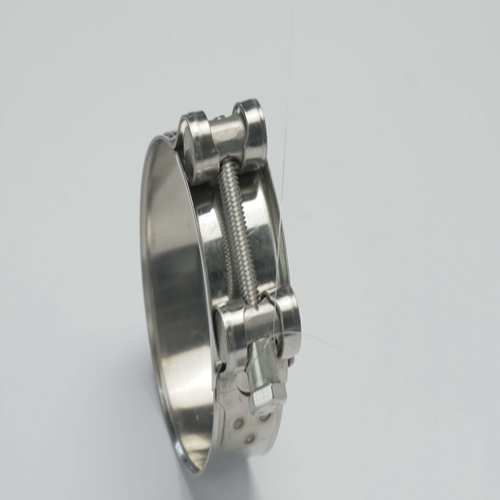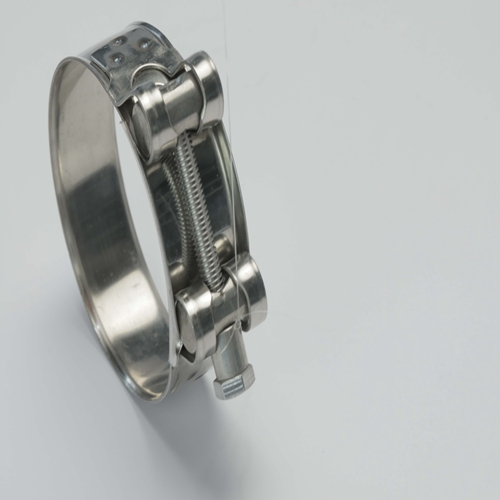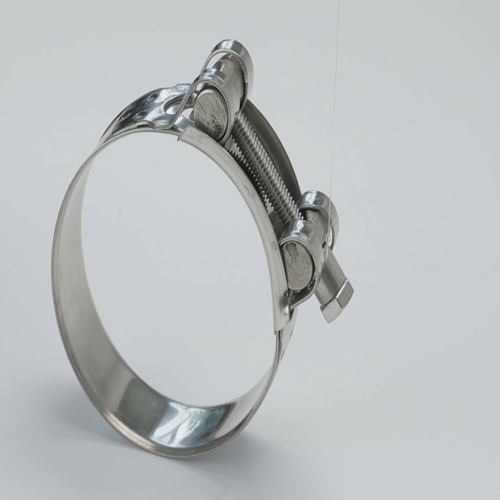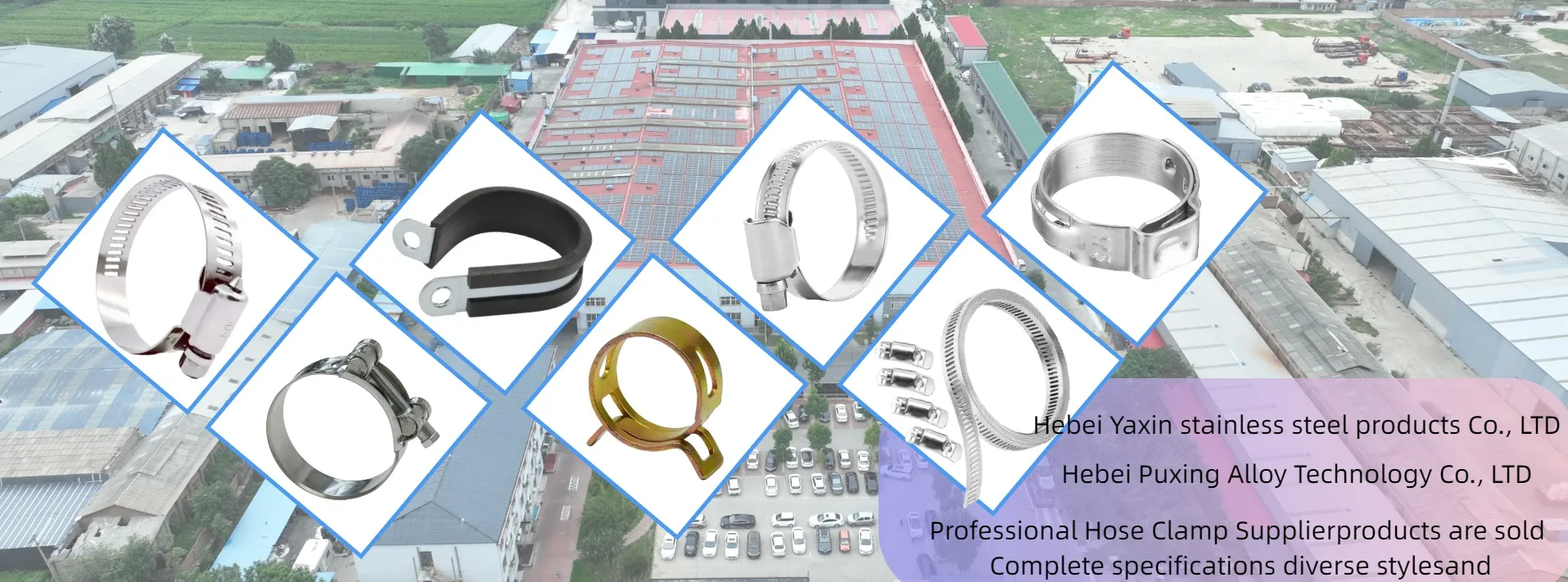- Phone:+86-17331948172 +86-0319-8862898
- E-mail: inquiry@puxingclamp.com
Lùna . 14, 2025 01:20 Back to list
Heavy Duty Hose Clamp: Stainless Steel for Secure & Durable Use
The Imperative Role of Heavy Duty Hose Clamps in Modern Industrial Applications
In industrial environments where durability, reliability, and leak-proof connections are paramount, the selection of appropriate fastening solutions is critical. Heavy duty hose clamp technology has evolved significantly to meet the rigorous demands of various sectors, including automotive, marine, petrochemical, and construction. These clamps are engineered to withstand extreme pressures, vibrations, and corrosive conditions, ensuring system integrity and preventing costly downtime. The global market for industrial clamps, including specialized hose clamps, is projected to grow consistently, driven by infrastructure development and the increasing complexity of fluid transfer systems. For instance, the demand from the automotive sector alone accounts for a significant share, with projections showing a compound annual growth rate (CAGR) of 4.5% for high-performance clamping solutions in vehicle fluid lines from 2023 to 2028, highlighting the indispensable nature of these components.
Beyond traditional applications, the advent of new energy vehicles and advanced manufacturing techniques further propels the need for robust and reliable clamping solutions. The emphasis is increasingly shifting towards materials that offer superior corrosion resistance and extended service life, such as stainless steel, which is critical for maintaining performance in harsh operating environments. Manufacturers are continually innovating, introducing designs that provide enhanced sealing capabilities, easier installation, and superior resistance to creep and fatigue. This evolution ensures that systems relying on these clamps operate efficiently and safely, reflecting a broader industry trend towards greater reliability and lower maintenance over the lifecycle of industrial equipment. Such advancements are pivotal for industries where safety and operational continuity are non-negotiable.
Technical Parameters & Performance Benchmarks for Robust Clamping
Understanding the precise technical specifications of heavy duty hose clamp is fundamental for engineers and procurement specialists. Key parameters often include material grade, band width, thickness, clamping range, and ultimate torque resistance. For instance, a typical heavy duty hose clamp designed for automotive or industrial fluid transfer might feature a band width of 12.7mm to 25.4mm and a thickness of 0.8mm to 1.5mm, fabricated from high-grade stainless steel like SS304 or SS316. These dimensions directly influence the clamp's ability to exert uniform radial pressure, critical for preventing leaks under high-pressure or high-vibration conditions. The choice between materials such as SS201 and SS304 depends heavily on the corrosive nature of the operating environment; SS304 offers superior resistance to a wider range of chemicals and atmospheric corrosion compared to SS201, which is often chosen for its cost-effectiveness in less demanding applications.
Testing standards, such as ISO 9001 and specific ASTM standards (e.g., ASTM F880 for general purpose hose clamps), dictate the minimum performance requirements for tensile strength, burst pressure, and corrosion resistance. A well-engineered heavy duty hose clamp should consistently pass tests verifying its ability to maintain a seal at pressures exceeding 50 PSI for common fluid lines, and significantly higher for hydraulic applications. The torque applied during installation is also a critical factor, with optimal torque values specified by manufacturers to ensure maximum sealing effectiveness without damaging the hose or the clamp itself. Improper torque can lead to premature failure, highlighting the need for precision tools and adherence to manufacturer guidelines during assembly. This commitment to precise engineering and rigorous testing ensures the long-term integrity of critical connections.

Typical Heavy Duty Hose Clamp Parameters
| Parameter | Typical Range / Value | Significance |
|---|---|---|
| Material Grade | SS201, SS304, SS316 | Corrosion resistance, strength, cost |
| Band Width | 12.7mm - 25.4mm (0.5" - 1") | Clamping force distribution, sealing area |
| Band Thickness | 0.8mm - 1.5mm | Durability, resistance to deformation |
| Clamping Diameter Range | Up to 600mm+ (24"+) for large clamps | Versatility for various hose sizes |
| Max. Installation Torque | 7 Nm - 25 Nm (50-220 in-lbs) | Achieving optimal seal without damage |
| Burst Pressure Rating | Typically 50-200 PSI for standard fluid lines | Resistance to internal system pressure |
| Operating Temperature | -40°C to +150°C (depending on material) | Suitability for various thermal environments |
Applications & Advantages: Where Robust Clamping Excels
The versatility of heavy duty hose clamps extends across a multitude of industries, providing critical connections in challenging environments. In the automotive sector, heavy duty automotive hose clamps are indispensable for securing coolant lines, fuel lines, and air intake systems, where they must withstand constant vibration, extreme temperature fluctuations, and exposure to various fluids. In the marine industry, stainless steel hose clamps, particularly those made from SS316, are preferred for their superior resistance to saltwater corrosion, ensuring the integrity of bilge pumps, exhaust systems, and raw water intake lines on vessels. The energy sector, encompassing oil & gas and petrochemical industries, relies on these clamps for maintaining leak-proof connections in pipelines, preventing hazardous leaks and ensuring operational safety, often under high-pressure and high-temperature conditions.
Beyond these, the construction and agricultural sectors utilize heavy duty adjustable stainless steel tube clips for securing hydraulic lines on heavy machinery, which endure significant shock and mechanical stress. The advantages of employing high-quality heavy duty stainless steel hose clamps are multi-fold. They contribute to enhanced system safety by minimizing the risk of fluid leaks, which can lead to equipment damage, environmental contamination, or even safety hazards. Their robust construction and corrosion-resistant properties translate into a significantly longer service life, reducing the frequency of replacements and associated maintenance costs. This leads to substantial operational savings and improved uptime, making them a wise investment for any industrial application where reliability cannot be compromised. The precision engineering of these clamps ensures a consistent and reliable seal, even after years of continuous operation in demanding conditions, thereby contributing to overall system longevity.

Manufacturing Excellence: The Process Behind Reliable Heavy Duty Hose Clamps
The production of a high-performance heavy duty hose clamp involves a meticulous manufacturing process that ensures consistent quality and durability. It typically begins with the selection of premium-grade stainless steel coils (SS201, SS304, or SS316), chosen for their specific metallurgical properties related to corrosion resistance and mechanical strength. This material undergoes precision slitting to achieve the desired band width, followed by progressive die stamping or roll forming to create the band profile, which often includes perforations for the worm drive mechanism. The housing components are typically stamped from heavier gauge material, while the screw is often cold-forged or machined for maximum strength and thread integrity. For specialized applications, CNC machining may be employed for critical components to achieve extremely tight tolerances and complex geometries, ensuring optimal fit and function.
Welding processes, such as spot welding or laser welding, are used to securely attach the housing to the band, creating a robust, unitary structure. Following assembly, each stainless steel hose clamp undergoes rigorous quality control checks. This includes visual inspection for defects, dimensional accuracy verification, torque testing to ensure consistent screw engagement, and often, salt spray corrosion testing to validate the material's environmental resistance as per ISO 9227 standards. Burst pressure tests are also conducted to verify the clamp's ability to withstand internal fluid pressures without failure. Adherence to international standards like ISO 9001 for quality management systems and ANSI standards for specific product types is paramount, ensuring that every clamp meets stringent performance and safety criteria before it leaves the factory. The focus on these precise manufacturing steps directly impacts the ultimate lifespan and reliability of the final product in demanding industrial settings, contributing to their long-term value and effectiveness.

Manufacturer Comparison & Customization Solutions
When selecting a supplier for heavy duty hose clamps, B2B buyers often consider several factors, including manufacturing capabilities, material certifications, testing protocols, and customization options. Reputable manufacturers, like those producing the Chinese factory Clamps heavy duty hose clamp SS201/SS304, distinguish themselves through consistent product quality and adherence to international standards. Comparing manufacturers often involves evaluating their expertise in specific material grades, such as their proficiency in working with SS304 for enhanced corrosion resistance versus SS201 for more economical applications. A key differentiator is the ability to provide detailed material traceability reports and certifications (e.g., Mill Certificates), confirming the alloy composition and ensuring compliance with industry regulations, such as those in the food processing or pharmaceutical sectors requiring FDA-compliant materials.
Customization is a significant aspect for many industrial clients. This can range from bespoke clamping ranges to unique band widths, specialized screw heads, or custom material finishes (e.g., passivation for enhanced corrosion resistance). Manufacturers capable of offering engineering support and rapid prototyping for specific application challenges demonstrate a higher level of partnership. For example, a client requiring a non-standard diameter for a large ducting system or a particular torque setting for an automated assembly line would benefit from a supplier with flexible production capabilities and a strong R&D team. The ability to provide customized branding or packaging for OEM clients further underscores a manufacturer's commitment to meeting diverse customer needs, solidifying their position as a valuable long-term partner in complex supply chains.

SS201 vs SS304 Heavy Duty Hose Clamps: A Comparison
| Feature | SS201 Heavy Duty Hose Clamp | SS304 Heavy Duty Hose Clamp |
|---|---|---|
| Corrosion Resistance | Good, but lower than SS304. Prone to pitting in high-chloride environments. | Excellent. Superior resistance to general corrosion and pitting, especially in mild to moderately aggressive environments. |
| Cost-Effectiveness | More cost-effective due to lower nickel content. | Higher cost than SS201 due to higher nickel content, offering better performance. |
| Applications | General purpose, less corrosive indoor/outdoor use, some automotive. | Marine, chemical processing, food & beverage, outdoor industrial, high-humidity. |
| Mechanical Properties | Good tensile strength, can be harder. | Excellent formability and weldability, good tensile strength. |
| Nickel Content | Lower (typically 3.5% - 5.5%). | Higher (typically 8% - 10.5%). |
Ensuring Trust: Quality Assurance & Customer Support
Building trust in the B2B sector for components like heavy duty hose clamps is achieved through transparent quality assurance, clear communication on delivery, and robust customer support. Companies committed to delivering superior heavy duty hose clamps typically uphold international certifications such as ISO 9001 for their quality management systems, ensuring every production batch meets stringent standards. This commitment extends to providing comprehensive documentation, including material test reports, dimensional inspection certificates, and performance test data. Partnerships with established logistics providers enable predictable and efficient global delivery cycles, crucial for clients managing just-in-time inventories. A typical delivery cycle for standard orders might range from 7-14 business days, while customized solutions could take 3-4 weeks, depending on complexity and order volume. Clear communication channels, including dedicated account managers and technical support teams, are essential for addressing client inquiries promptly and effectively.

Furthermore, a strong warranty policy underscores a manufacturer's confidence in their product. For instance, a standard 12-month warranty against manufacturing defects provides peace of mind for buyers, ensuring long-term product performance and reducing procurement risks. Beyond warranties, responsive after-sales support, including troubleshooting assistance, replacement part availability, and technical guidance, is paramount. This level of comprehensive support reinforces customer confidence and fosters long-term business relationships. For instance, a client requiring heavy duty adjustable stainless steel tube clips for a critical new project can rely on expert advice on installation best practices or material selection, illustrating the true value of a reputable supplier. This holistic approach to product quality and customer service is what differentiates industry leaders in the competitive market for industrial clamping solutions.
Frequently Asked Questions (FAQ) about Heavy Duty Hose Clamps
Q1: What defines a heavy duty hose clamp compared to a standard hose clamp?
A heavy duty hose clamp is characterized by its robust construction, typically using thicker and wider stainless steel bands, stronger housings, and more durable screw mechanisms. These design choices enable them to withstand higher pressures, greater vibrations, and more severe corrosive environments than standard clamps. They are designed for applications where failure is not an option, providing enhanced torque resistance and a superior, long-lasting seal.
Q2: What is the typical lifespan of a stainless steel hose clamp in industrial use?
The lifespan of a stainless steel hose clamp largely depends on the material grade and the operating environment. A high-quality SS304 or SS316 clamp can last anywhere from 5 to 15 years or more in typical industrial conditions, especially if properly installed and maintained. In highly corrosive environments, even these materials may see reduced lifespans, necessitating more frequent inspection and replacement schedules.
Q3: Can heavy duty automotive hose clamps be reused?
While some heavy duty automotive hose clamps can technically be reused, it is generally not recommended, especially in critical applications. The clamping mechanism and band may experience fatigue or deformation after initial tightening, compromising their ability to provide an optimal seal upon reinstallation. For critical fluid systems, using a new clamp ensures maximum reliability and safety, adhering to best practice for preventing leaks and system failures.
Q4: How do I choose the correct size of heavy duty hose clamp?
To choose the correct size, you need to measure the outer diameter (OD) of the hose or pipe connection point once the hose is installed over the fitting. Select a heavy duty hose clamp whose clamping range encompasses this measured OD. It is crucial to select a clamp where the measured OD falls roughly in the middle of the clamp's adjustable range to allow for optimal tightening and expansion/contraction during operation, ensuring maximum sealing integrity.
Concluding Thoughts and Future Outlook
The continuous innovation in heavy duty hose clamps underscores their critical role in ensuring the integrity and efficiency of industrial and automotive fluid transfer systems. As industries evolve, driven by demands for higher performance, greater energy efficiency, and environmental compliance, the specifications and capabilities of these essential components will continue to advance. Manufacturers are increasingly focusing on materials that offer enhanced resistance to specific chemicals and extreme temperatures, alongside designs that facilitate quicker installation and inspection. The drive towards smarter manufacturing also implies a future where clamps might incorporate sensors for real-time monitoring of tension or leakage, although this remains largely in the R&D phase.

The comprehensive understanding of technical parameters, meticulous manufacturing processes, and dedicated customer support are not just features but fundamental pillars that establish trust and authority in the B2B market for heavy duty hose clamps. As global supply chains become more interconnected, the emphasis on certified quality, efficient delivery, and adaptable customization solutions will only intensify. For businesses seeking reliable and durable clamping solutions, partnering with a manufacturer that demonstrates expertise, experience, authoritativeness, and trustworthiness is paramount for long-term operational success and reduced total cost of ownership.
References
- ASTM International. (2022). ASTM F880/F880M - 22: Standard Specification for Seamless and Welded Ferritic/Austenitic Stainless Steel Pipe for General Corrosion Service.
- International Organization for Standardization. (2015). ISO 9001:2015 - Quality management systems — Requirements.
- ASM International. (2001). ASM Handbook, Volume 1: Properties and Selection: Irons, Steels, and High-Performance Alloys.
- Society of Automotive Engineers (SAE International). (2020). SAE J1508: Hose Clamp Specifications.
- NACE International (AMPP). (2016). NACE SP0408-2016 - Methods for Qualification of Protective Coatings and Linings for Immersion Service.
-
Large Stainless Steel Adjustable American Type Hose Clamp - Puxing Clamp | Corrosion Resistance&Adjustable Design
NewsAug.14,2025
-
Heavy Duty Hose Clamp: Stainless Steel for Secure & Durable Use
NewsAug.14,2025
-
Large Stainless Steel Adjustable American Type Hose Clamp - Hebei Pux Alloy Technology Co., Ltd
NewsAug.13,2025
-
Large Stainless Steel Adjustable American Type Hose Clamp - Hebei Pux Alloy Technology Co., Ltd. | Corrosion Resistance, High Torque
NewsAug.13,2025
-
Large Stainless Steel Adjustable Hose Clamp - Hebei Pux Alloy Technology Co., Ltd
NewsAug.13,2025
-
High Quality Hose Clamps & Mini Clips - German Stainless Steel
NewsAug.13,2025




